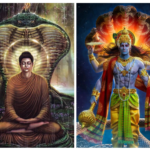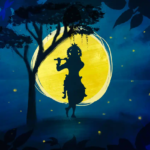The Bhagavad Gita is a sacred text of Hinduism that is considered to be one of the most important philosophical and spiritual texts in the world. It is a dialogue between the warrior Arjuna and his charioteer Krishna, who is an incarnation of the god Vishnu. The Gita is set on the eve of a great battle, and Arjuna is filled with doubts about whether he should fight. Krishna then gives him a long discourse on the nature of reality, the purpose of life, and the path to liberation.
The Bhagavad Gita covers a wide range of topics, but some of the main points include:
- The concept of the atman, or the eternal self. The atman is the true essence of each individual, and it is not bound by the body or the mind.
- The law of karma, which states that every action has a reaction. Good actions lead to good results, and bad actions lead to bad results.
- The concept of dharma, which is one’s duty or purpose in life. Each person has a unique dharma, and it is important to fulfill it to the best of one’s ability.
- The path to moksha, or liberation from the cycle of birth and death. Moksha can be achieved through self-knowledge, meditation, and devotion to God.
The Concept of the Atman
The atman is the central concept in the Bhagavad Gita. It is the eternal self, the unchanging essence of each individual. The atman is not born, does not die, and is not affected by the changes that take place in the body or the mind.
The atman is often compared to a lamp. Just as a lamp remains the same even though the flame may flicker, the atman remains the same even though the body and mind may change.
The realization of the atman is the goal of all spiritual practice. When we realize that we are not our bodies or our minds, but the eternal atman, we are free from suffering and attachment.
The Law of Karma
The law of karma is another important concept in the Bhagavad Gita. It states that every action has a reaction. Good actions lead to good results, and bad actions lead to bad results.
The law of karma is not a punishment or reward system. It is simply a natural law that governs the universe. When we understand the law of karma, we can learn to make choices that will lead to positive results.
The Concept of Dharma
Dharma is one’s duty or purpose in life. It is different for each individual, but it is always something that is good and positive.
Fulfilling one’s dharma is essential for living a happy and fulfilling life. When we live in accordance with our dharma, we feel a sense of peace and satisfaction.
The Path to Moksha
Moksha is liberation from the cycle of birth and death. It is the ultimate goal of all spiritual practice.
There are many different paths to moksha, but they all involve self-knowledge, meditation, and devotion to God.
Self-knowledge is the realization of the atman. When we know who we really are, we are free from the attachments that keep us trapped in the cycle of birth and death.
Meditation is a way of calming the mind and focusing on the present moment. It helps us to see things clearly and to make wise choices.
Devotion to God is a way of connecting with the divine and receiving guidance and support.
The Bhagavad Gita is a complex and profound text, but its central message is simple: life is a journey of self-discovery and that the path to happiness and fulfillment lies in living a life of truth, compassion, and non-violence.
The Gita is a valuable resource for anyone who is seeking spiritual guidance or who wants to learn more about the meaning of life. It is a timeless text that has been cherished by millions of people for centuries.
Here are some additional life lessons that we can learn from the Bhagavad Gita:
- We should not be attached to material things or to the results of our actions.
- We should always act with compassion and love.
- We should be willing to sacrifice our personal desires for the greater good.
- We should never give up on our dreams, no matter how difficult they may seem.
- We should always remember that we are all connected, and that we are all part of something larger than ourselves.
The Bhagavad Gita is a powerful and inspiring text that can help us to live better lives. It is a text that is worth reading and studying, and it is a text that can bring us wisdom and guidance.
If you are interested in learning more about the Bhagavad Gita, there are many resources available. You can find translations of the text, commentaries, and books on the philosophy of the Gita. You can also find online courses and workshops that can help you to understand and apply the teachings of the Gita to your own life.
The Bhagavad Gita is a timeless text that has something to offer everyone. It is a text that can help us to live better lives, to find peace and happiness, and to connect with the divine.
Here are some tips for applying the teachings of the Bhagavad Gita to your own life:
- Read the Gita regularly and reflect on its teachings.
- Find a teacher or mentor who can help you to understand the Gita.
- Practice meditation and yoga to calm your mind and connect with your inner self.
- Serve others and do good deeds to cultivate compassion and love.
- Be willing to sacrifice your personal desires for the greater good.
- Never give up on your dreams, no matter how difficult they may seem.
- Remember that you are not alone and that you are part of something larger than yourself.
The Bhagavad Gita is a rich and complex text that can be interpreted in many different ways. However, its central message is clear: life is a journey of self-discovery and that the path to happiness and fulfillment lies in living a life of truth, compassion, and non-violence.
If you are looking for guidance and inspiration on your own journey, the Bhagavad Gita is a valuable resource. It is a text that can help you to live a better life and to find peace and happiness.
I hope this blog post has been helpful. If you have any questions, please feel free to ask.


